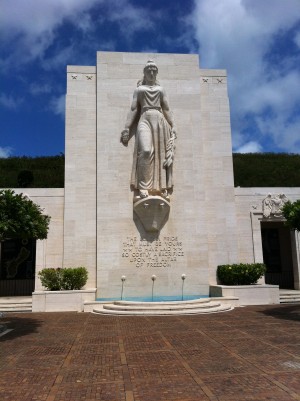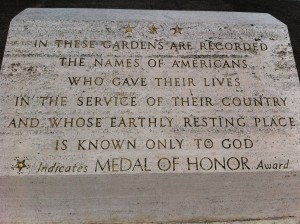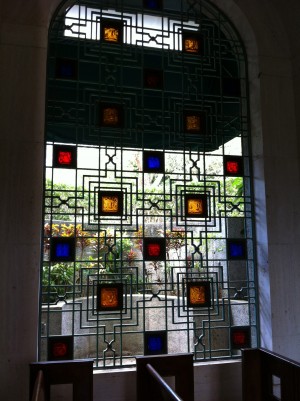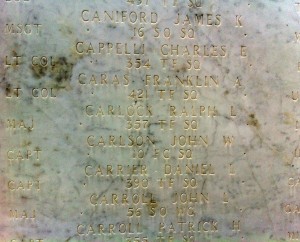
National Memorial Cemetery of the Pacific
I didn’t set out to find him. In fact, when Nancy McVean suggested that Rene’ and I visit Punchbowl cemetery during our time in Honolulu, I had no idea what she was talking about. The Arizona? Sure, everyone has seen Tora, Tora, Tora, or the more recent Pearl Harbor, or newsreel footage of F.D.R. addressing Congress on December 8, 1941 giving his “day of infamy” speech. And Diamond Head, Waikiki, and the iconic State Supreme Court building used by Hawaii-Five-O as its headquarters in the television series, are familiar to anyone over the age of five. But Punchbowl cemetery? Never heard of it. And I doubt if any of you, unless you are from a military family or background, know that it exists.
The cemetery’s official name is the National Memorial Cemetery of the Pacific. The cemetery sits on top of an extinct volcano known as Punchbowl crater that looms behind downtown Honolulu. The site has clear vistas of Diamond Head, Pearl Harbor, and H-1, the freeway leading to the Marriott complex where we are staying. The ride up the twisting roadway to the crater is reminiscent of Duluth’s Skyline Parkway except that palm trees and exotic tropical foliage line the steep roadside instead of birch, maple, and pine. I’m glad we agreed to Nancy’s suggestion: my visit to Punchbowl proved to be the highlight of my visit to Oahu.

The Memorial at Punchbowl
What appears curious driving into the banyan-tree-shaded main drive of the cemetery is that there are no headstones. Each soldier, sailor, Coastie, airman, or Marine who has been placed here for his or her eternal rest is equal in stature and rank despite whatever position he or she may have held in the military or in life. There are no ornate headstones or sculpted monoliths adorning the graves; only meager footstones with the individual names and other basic information, including the names of spouses if the spouse is similarly interned.
Workers carefully mow grass, trim brush, and manicure the site with reverence. Graves flow out from the white marble memorial that sits at the far end of the field of green, the banyan trees leading visitors to the shrine like so many sentries watching over the dead. I look back, over Honolulu, and admit that Nancy was right to insist that we visit Punchbowl.

Plaque
This is no ordinary monument but one of several located around the world paying homage to MIAs; American servicemen and women from WWII, Korea, and Vietnam who died in the service of their nation but whose remains were never recovered. Here the carved names of over 28,000 men and women, who, as the plaque suggests, rest in far flung corners of this earth, are identified so that the living can pay their respects to those who served. The marble wall holding the names of the fallen is the only place where distinctions are made: Individuals awarded the Medal of Honor have a gold star affixed next to their name on the wall.
As Rene’, Ron and Nancy McVean, and I make our way up the stairs of the memorial and take in the colorful panels that display information about the war in the Pacific, the Korean Conflict, and the Vietnam War, the germ of a thought, a memory, intrudes.
I wonder if Mr. Carlock’s name is here?
I’m just old enough to have held a draft card. I turned 18 in 1973 and despite my concerns about Vietnam, I did my duty and registered with Selective Service. Though the last call-up of lottery numbers was in 1972, priority was still assigned to potential draftees until 1975. In 1974, my lottery number was 53. Had the draft actually been held and I wasn’t in a deferred status (or, as my mother suggested, hiding in Canada), I would’ve been slogging through the rice paddies of Southeast Asia with leeches stuck to my face, an M-16 cradled in my arms, and fear in my eyes.
I was, as most of you know, politically savvy in my youth. A Humphrey supporter, I’d been behind the war effort in Vietnam until Bobby Kennedy and Dr. King turned my heart. After my conversion, I marched with the long hairs and the peaceniks in front of Duluth’s federal courthouse in opposition to the war. All this is background so that you can understand that the Vietnam War touched me in ways that left vivid, if somewhat dim, memories and emotions. This history bubbles and boils within me as I stand on the steps at Pacific Memorial Cemetery thinking about one man, one pilot, who lost his life in Vietnam.
My parents built a new house in the Piedmont Heights neighborhood of Duluth, MN in 1968. We moved into the place during the summer between my eighth and ninth grade years. I learned that a war widow, Mrs. Lois Carlock, a slender, kind, mother of two kids, a boy and a girl, lived in a white house just up the block from us. Somehow, maybe through my parents, maybe through other neighborhood kids, I learned that Lois’s husband had been a combat pilot in the war, had been shot down, and died.
Standing in the clean, warm air of Oahu, I remember the fallen pilot because I’d coached his son in football. Jeff Carlock was born in 1962, making him about ten or eleven when I coached him. But beyond recalling that tidbit and the name “Carlock”, I find myself clueless. I’m unsure that Mr. Carlock was actually MIA. I also have no idea what branch of the service he was attached to. Being he was a fighter pilot, and being I know something about the military (I’m honorably discharged from the USAR), I know he had to be Air Force, Marines, or Navy. With this slender information in mind, I visit the cemetery chapel and try to remember more.

Chapel window
God doesn’t intervene. No heavenly revelations spur my mind to detail. I leave the sacred space and descend stairs seeking marble walls where the names of the Vietnam missing are immortalized in stone. I start with the Navy and the Marines. I look through all the “c’s”. I don’t see the name “Carlock”.
Maybe it’s spelled “Karlock”.
Nope. I read the names on the walls depicting lost airmen and soldiers. I search amongst the fallen, the lost. I find his name.

But I’m skeptical. The inscription lists Major Ralph Carlock’s state of residence as Illinois.
I thought he was from Duluth.
Using my iPhone, contemplating a father being taken from his children, a husband from his wife, a neighbor from his neighbors, I research the name on the Internet. I confirm that Major Ralph L. Carlock, the name inscribed into the white marble of the Pacific Memorial Cemetery, is the man I’m looking for. On March 4, 1967 while flying over Laos, Major Carlock’s F105 was hit by enemy fire. The plane crashed and the pilot died. The major was lost to jungle until his grave was discovered after the cessation of hostilities. Lois Carlock was still alive when her husband’s remains were shipped state-side in 2003. Sadly, Lois (born Lois Johnson on 02/11/1938 in Duluth), died on 07/02/2004, not long after Major Carlock was re-interred on American soil. Today, Lois rests next to Ralph in Sunrise Memorial Cemetery in Hermantown, MN, the couple finally reunited after nearly forty years of separation.
I don’t know what happened to the little boy and girl who played in front of the white house on Leonard Street in Piedmont Heights just up the hill from where I grew up. I hope they’ve lived full and complete lives despite losing their father when they were very young. I also hope they know that Major Ralph Carlock’s sacrifice hasn’t been forgotten.
Peace.
Mark



thank you for the beautiful article about my uncle. I was a teenager when we found out he was MIA.
Linda: I remember Jeff and his sister as neat little kids in the neighborhood. I grew up a couple of houses away. Lois was a really nice lady and a great mom despite the loss she suffered due to the war. I was so lucky to find out the rest of your uncle’s story when I visited the memorial in Hawai’i. And thanks for reading the blog! You can check out my other posts and my books on the same site.
Mark
Mark,
Wow, been more than a few years.
Lots of details, will have to write another E-mail to you (please respond to my JCinNavy@Gmail account so I can respond).
Just one quick detail.
On Easter 2003, I went to visit my Mom, asked her about her upcoming death (she had cancer for 6+ years at the time, wanted to give her a chance to open up if she needed), I was shaking, very unprepared for it. She was calm, stated one thing that surprised her was how much peace it gave her, knowing that when the time comes, she will be buried next to her husband. (wow, that was 37 years ago {at that time in 2003}). As it turned out, she passed away 1-2 weeks before the ceremony to recommit to burial. It was a very moving ceremony, lots of details. At the cemetery, there were two coffins, side by side, completely covered, one in our flag, the other in flowers. Seems once she had the info on her husband, seen her two kids get married and have daughters, she had finished everything and was ready to go.
Will write/respond later.
V/R,
Jeffrey Carlock
[email protected]
Jeff: I responded via email with my email address. Nice to hear from you.
Mark